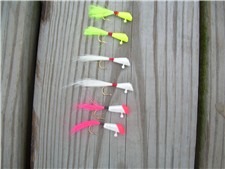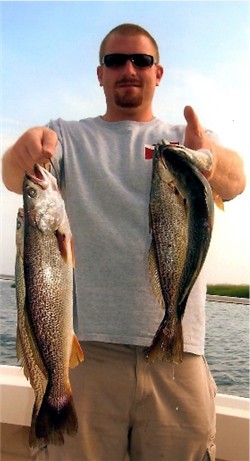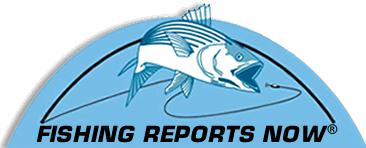page 2 of 2 |
|
| Fast, Furious, But Delicate | |
Continued from previous page ... |
|
 Examples of shad darts in different colors. |
In other words, fish early, very early. That avoids boat traffic, puts you on the fishing grounds before anyone else, and also is just a time of day when many fish are active: first light. |
 Jigging with leadheads and soft plastics is another technique for weaks. Bass Kandy Delights like these work well. |
If the bite stops, two things are possible. Either predators like bluefish showed up, or the weakies began to gather too far behind the boat. Steve either sticks the three shrimp onto a 1/8-ounce shad dart with a gold hook or a plain, No. 2 or 3 gold hook. |
Experiment with depth, and find the depth the fish prefer that day. Try fishing without the bobber, and try fishing with the bobber so that the dart or hook is 1 foot underneath, 3 feet under, 6 feet, 8 feet and so on. |
|
Sometimes no action is imparted to the bait. But sometimes Steve will “pop” a dart when it’s under a bobber, especially if no fish are biting otherwise, because that can make a difference. When using the other technique, jigging, Steve will either throw a jig with something like a Bass Kandy Delight or bucktails either with nothing added to the hook or with something added such as a Berkley Gulp, and the chartreuse and pink swimming mullet is a favorite. Steve uses two types of action when jigging. |
 Early season shrimping tends to produce the bigger weaks. |
This particular population of weakfish—the smaller, schoolie fish—usually enters the bay around mid June, and they migrate from southern waters, and Steve says they usually arrive about the same time that croakers start appearing, and maybe there’s a connection, because they’re from the same family. These weaks stick around in the bay through mid September. The early season usually brings the biggest ones, maybe 18 to 24 inchers, but every year is different. Later in the season the size usually decreases but the number of the trout increases. The weaks can generally range 10 inches to 5 or 6 pounds throughout the season. Larger, “tiderunner” weakfish, big fish like 8-, 10- or 12-pounders, enter the bay earlier in the year in spring to spawn for a while and then depart. The weakies talked about in this article are smaller, schoolie weaks that make up the bay’s main population of the trout. After September weakfish stage for a moment near the ocean beaches, and they hit metal jigs very aggressively, unlike any other time of year, and during some years can be quite large. But that’s a whole different type of fishing and a subject of another article. An aside. Weakfish have been disappearing from many areas in the state. Places like Delaware Bay, billed as the weakfish capital of the world, have been alarmingly barren of weakfish in the past years. The cause is unknown and is not blamed on recreational fishing. Even a recent article about weaks in an issue of Fisheries Focus, a newsletter published by the Atlantic States Marine Fisheries Commission, an agency that helps regulate fisheries management, was titled, “The Challenge of Managing a Stock Decline When Fishing Is Not the Cause.” That article said the weakfish stock status is “depleted, overfishing is not the cause.” The cause is unknown. For whatever reasons, Barnegat Bay’s weakfish population seems to be relatively thriving. Another mystery, but there seems to be no reason whatsoever to be concerned about catching these weakies within the legal limit. Fast, furious, but delicate. It’s a wonderful fishery, great fun, and a beautiful, interesting fish. It’s also good fishing for the kids, because they’re kept busy, and there can be a variety of species landed. Steve’s trips can average 40 to 100 weakies, and of course most of the fish aren’t kept. They are good-eating, though. Although the action can be fast, it’s not simple fishing, especially for the novice, and it takes experience with the technique. I remember being anchored at Meyer’s Hole with a captain who knew what he was doing, and we were catching non-stop weaks in a grass-shrimp slick, while boaters 10 feet away caught nothing. One of the best ways to learn any fishing is to take a trip with a local captain. Give Steve a ring to shorten the learning curve, or just give him a call to book one of the more interesting, enjoyable trips of the summer. |
|


